#X-ray Observatory
Explore tagged Tumblr posts
Text

"This new image of NGC 2264, also known as the 'Christmas Tree Cluster,' shows the shape of a cosmic tree with the glow of stellar lights. NGC 2264 is, in fact, a cluster of young stars — with ages between about one and five million years old — in our Milky Way about 2,500 light-years away from Earth. The stars in NGC 2264 are both smaller and larger than the Sun, ranging from some with less than a tenth the mass of the Sun to others containing about seven solar masses.
This new composite image enhances the resemblance to a Christmas tree through choices of color and rotation. The blue and white lights (which blink in the animated version of this image) are young stars that give off X-rays detected by NASA’s Chandra X-ray Observatory. Optical data from the National Science Foundation’s WIYN 0.9-meter telescope on Kitt Peak shows gas in the nebula in green, corresponding to the 'pine needles' of the tree, and infrared data from the Two Micron All Sky Survey shows foreground and background stars in white. This image has been rotated clockwise by about 160 degrees from the astronomer’s standard of North pointing upward, so that it appears like the top of the tree is toward the top of the image.

Young stars, like those in NGC 2264, are volatile and undergo strong flares in X-rays and other types of variations seen in different types of light. The coordinated, blinking variations shown in this animation, however, are artificial, to emphasize the locations of the stars seen in X-rays and highlight the similarity of this object to a Christmas tree. In reality the variations of the stars are not synchronized.
The variations observed by Chandra and other telescopes are caused by several different processes. Some of these are related to activity involving magnetic fields, including flares like those undergone by the Sun — but much more powerful — and hot spots and dark regions on the surfaces of the stars that go in and out of view as the stars rotate. There can also be changes in the thickness of gas obscuring the stars, and changes in the amount of material still falling onto the stars from disks of surrounding gas.
NASA’s Marshall Space Flight Center manages the Chandra program. The Smithsonian Astrophysical Observatory’s Chandra X-ray Center controls science operations from Cambridge, Massachusetts, and flight operations from Burlington, Massachusetts."
Date: December 19, 2023
NASA ID: link
#NGC 2264#Christmas Tree Cluster#Space#Galaxy#NASA#December#2023#gif#Chandra X-ray Observatory#X-ray Observatory#Chandra#Marshall Space Flight Center#MSFC#Huntsville#Alabama#my post
62 notes
·
View notes
Text
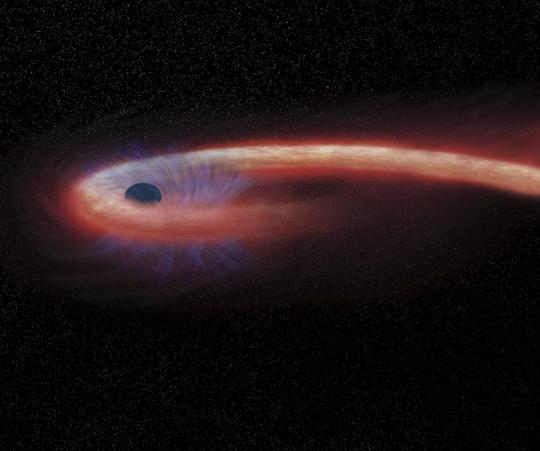
Black holes use gravity to pull matter into them.
NASA/Chandra X-ray Observatory/M.Weiss via AP
103 notes
·
View notes
Text

Hubble and NASA’s Chandra X-ray Observatory have uncovered a pair of supermassive black holes that are just 300 light-years apart. They are buried deep inside the heart of a pair of colliding galaxies that will eventually merge to make a bigger black hole: https://bit.ly/3YpIM3Q
#space#astronomy#stsci#science#nasa#universe#hubble#hubble space telescope#chandra#chandra x ray observatory#black hole#galaxies
55 notes
·
View notes
Text
Scientists have discovered the oldest black hole yet, a cosmic beast formed a mere 470 million years after the Big Bang. The findings, published Monday, confirm what until now were theories that supermassive black holes existed at the dawn of the universe. NASA's James Webb Space Telescope and Chandra X-Ray Observatory teamed up over the past year to make the observations. Given the universe is 13.7 billion years old, that puts the age of this black hole at 13.2 billion years. Even more astounding to scientists, this black hole is a whopper—10 times bigger than the black hole in our own Milky Way.
Continue Reading.
174 notes
·
View notes
Text

Chandra & JWST: the most distant black hole ever detected in X-rays at an early stage of growth, where its mass is similar to that of its host galaxy - potentially explaining how some of the first supermassive black holes in the universe formed (November 6, 2023)
#astrophotography#black hole#galaxy#galaxies#galaxy uhz1#universe#astronomy#krakenmare#nasa#space#jwst images#jwst#chandra x ray observatory#chandra
48 notes
·
View notes
Text
The Chandra X-Ray Observatory, after deployment on STS-93.
48 notes
·
View notes
Text
The celestial object of the day is El Gordo!


This galaxy cluster is located 7 billion light-years away from Earth, and it formed when the universe was only half the age it is currently. Its ginormous mass (2.1 quadrillion solar masses) helps scientists see galaxies that are very far away thanks to gravitational lensing
#Image credit: NASA/ESA/SOAR/CSA#One of the telescopes that helped its discovery was Chandra#Thank Chandra!! Cool as always#astronomy facts#astronomy#astrophotography#outer space#space#nasa#nasa photos#science#space exploration#space photography#celestial object of the day#james webb space telescope#jwst#jwst images#esa#astrophysics#chandra x ray observatory#El Gordo#galaxy cluster
44 notes
·
View notes
Text

Revenge on @nekomacbeth's Chandra !
Also a great excuse to do a Hades artstyle study hehe
#There may be no escape but there is certainly upper back pain#Finally grasped the Hades style in my greasy hands#Also this Chandra was so fun to draw ouggghh#digital art#fanart#art fight#art fight 2024#gijinka art#gijinka#spacecraft#chandra x ray observatory#hades game
30 notes
·
View notes
Text
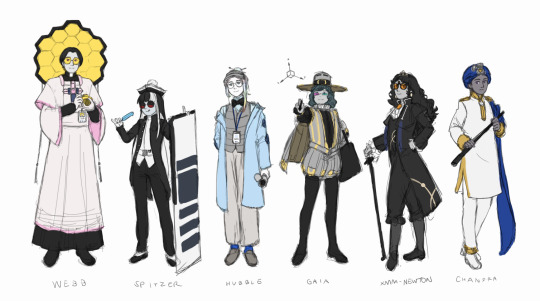
Telescopes 👀😶
#space#character design#gijinka#personification#nasa#esa#space telescope#oh boy time to tag everybody hang tight#jwst#james webb space telescope#spitzer space telescope#hubble#esa gaia#xmm-newton#chandra x ray observatory#religious imagery#priests#christian imagery#thanks webb#artists on tumblr
219 notes
·
View notes
Text



24 December 2023
💚🎄💚
#NASA#Christmas Tree Cluster#Christmas Tree#stars#space#galaxy#universe#cosmos#Christmas#Christmas Eve#Chandra X-ray Observatory#space telescope#space observatory#X-ray astronomy
36 notes
·
View notes
Text

A “Green Monster” Lurks in Star’s Debris
For the first time, astronomers have combined data from NASA’s Chandra X-ray Observatory and James Webb Space Telescope to study the well-known supernova remnant Cassiopeia A (Cas A). This work has helped explain an unusual structure in the debris from the destroyed star called the “Green Monster,” because of its resemblance to the wall in the left field of Fenway Park.
Image Credit: X-ray: NASA/CXC/SAO; Optical: NASA/ESA/STScl; IR: NASA/ESA/CSA/STScl/Milisavljevic et al., NASA/JPL/CalTech; Image Processing: NASA/CXC/SAO/J. Schmidt and K. Arcand
#art#cosmos#cosmic#universe#blast#space#photography#stars#monster#green#debris#chandra x ray observatory#james webb space telescope#supernova#cassiopeia#casA
65 notes
·
View notes
Text
*This is very serious.*
REBLOG TO SPREAD AWARENESS AND SAVE X-RAY ASTRONOMY
12 notes
·
View notes
Text

The bright flash of a solar flare captured by NASA's Solar Dynamics Observatory.
Dazzling images of the sun
(Image credit: NASA)

Active regions of the sun are shown with X-Ray imaging taken by the NuSTAR telescope.
#nasa#photographer#sun#space#astronomy#science#solar flare#nature#nasa's solar dynamics observatory#nustar telescope#x-ray image
24 notes
·
View notes
Text
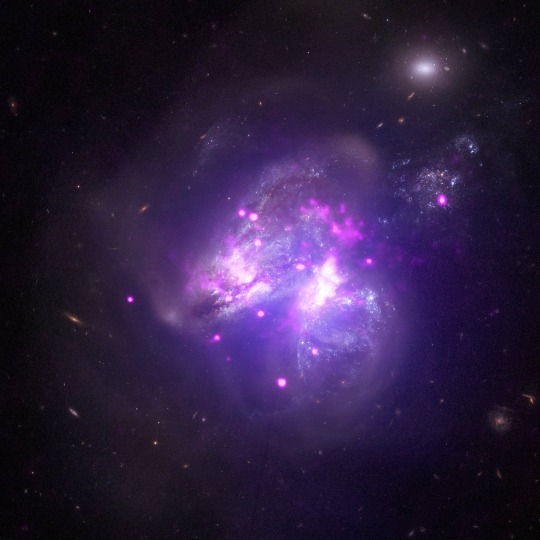
💫 “Today Chandra is studying a Black Hole in Ursa Major. Nearby in the sky two galaxies are merging in Arp 299. At least 14 "ultra-luminous X-ray sources" (ULXs) have been discovered here. All are likely black holes or neutron stars pulling material from a companion star.”
source . more from chandra x-ray observatory .
#space#chandra#chandra observatory#chandra x ray observatory#nasa#outer space#black hole#Ursa Major#constellations#neutron stars#stars#neutron star#galaxy#galaxies#space photography#astronomy
98 notes
·
View notes
Text
The Christmas Tree Cluster
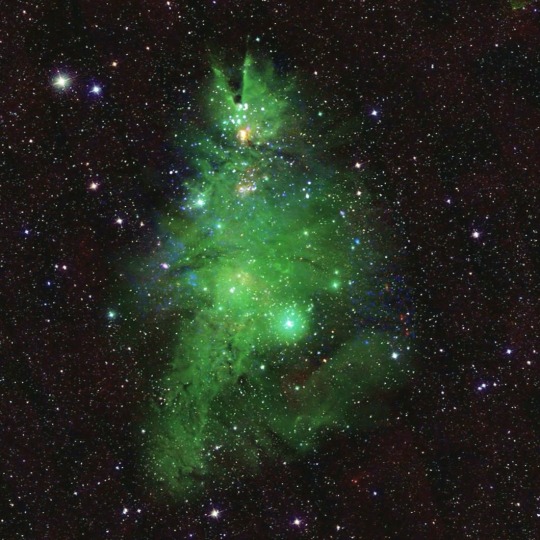
About 2,500 light-years from Earth, this community of young stars (less than 5 million years old - our middle-aged Sun has been burning for more than 5 billion years) give off X-rays that help light up the green nebula surrounding them, giving this cluster (NGC 2264) its nickname.
18 notes
·
View notes
Text
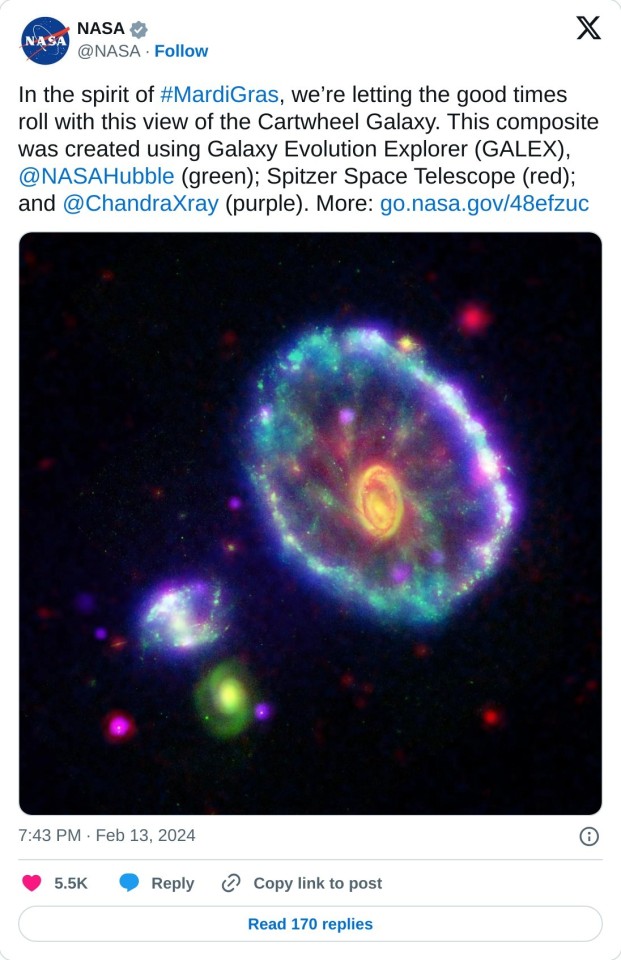
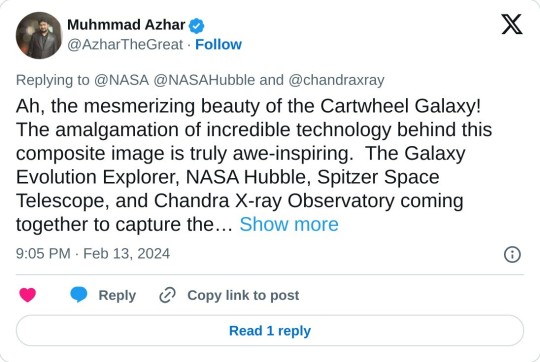
cosmic dance of colors. Its a splendid tribute to the power of human curiosity and the wonders of the cosmos. Thanks for sharing this celestial marvel!
#this is my favorite#MardiGras#Cartwheel Galaxy#galaxy#Spitzer Space Telescope#galaxies#hubble space telescope#chandra x ray observatory#beautiful nature#amazing nature#astronomy#Nasa
8 notes
·
View notes
